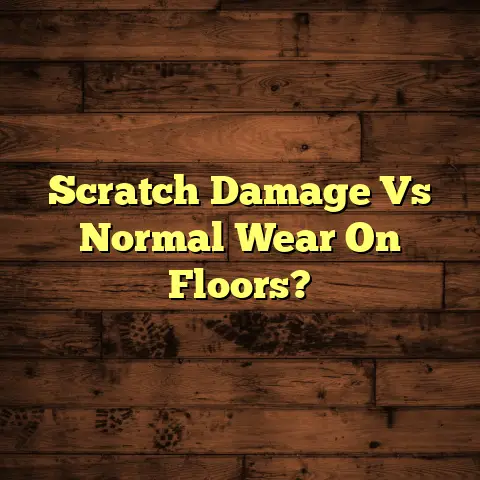Dog Pee on Hardwood? (4 Stain Erasers!)
Let’s be honest, we adore our furry friends, but accidents happen, right?
And when those accidents involve dog pee and hardwood floors, well, that’s when the frustration kicks in.
I’ve seen it all in my years as a flooring contractor.
That sinking feeling when you spot that dreaded puddle, the lingering odor that just won’t quit…
It’s enough to make any pet owner consider a full floor replacement!
But hold on! Don’t reach for the demo bar just yet.
There’s hope!
In this article, I’m going to share my expert tips and tricks for tackling dog pee stains on hardwood, focusing on four powerful “stain erasers” that can help you reclaim your floors and your sanity.
Ready to dive in? Let’s get started!
1. Understanding the Problem
So, why is dog pee such a menace to hardwood floors?
It’s not just the smell (though that’s bad enough!).
Dog urine is highly acidic, and that acidity can wreak havoc on your floor’s finish.
Think of that protective layer as your floor’s first line of defense.
Urine can penetrate that finish, seeping into the wood fibers below.
Once it’s in there, it can cause:
-
Discoloration: That yellowish or dark stain is a sign that the urine has altered the wood’s natural color.
-
Odor Issues: Even after cleaning the surface, the smell can linger because the urine has soaked into the wood.
-
Damage to the Wood: Over time, the acidity can break down the wood fibers, leading to warping, cupping, or even rot.
I’ve seen floors where repeated accidents have caused significant structural damage, requiring extensive repairs.
That’s why it’s crucial to act fast!
The longer the urine sits, the deeper it penetrates and the harder it is to remove.
Think of it like a spilled glass of red wine on a white carpet – the sooner you blot it up, the better your chances of saving the day (or in this case, your floor!).
2. The Quick Fix
Okay, so you’ve just discovered a fresh puddle of dog pee.
Don’t panic!
Here’s what you need to do immediately:
-
Blot, Blot, Blot: Grab a stack of paper towels (I prefer the heavy-duty kind) and start blotting up as much urine as possible.
Don’t rub! Rubbing will only spread the stain and push the urine deeper into the wood.
Apply firm pressure and keep blotting until the paper towels come up mostly dry.
-
Rinse with Mild Soap and Water: In a bucket, mix a small amount of mild dish soap (like Dawn) with warm water.
Dampen a soft cloth with the soapy water and gently wipe the affected area.
Again, avoid scrubbing!
-
Dry Thoroughly: Use a clean, dry cloth to thoroughly dry the area.
You can even use a fan to speed up the drying process.
Moisture is the enemy when it comes to hardwood, so make sure it’s completely dry.
-
Odor Neutralizer (Optional): For an extra layer of defense against lingering odors, you can spray a pet-safe odor neutralizer on the area.
I’m a fan of Nature’s Miracle. It contains enzymes that break down the odor-causing molecules.
Just be sure to follow the product’s instructions carefully.
This quick fix is your first line of defense.
It won’t necessarily remove existing stains, but it will help prevent further damage and minimize odors.
Think of it as damage control before you bring in the heavy artillery – which is where our four stain erasers come in!
3. The Four Stain Erasers
Alright, let’s get down to the real magic: removing those stubborn dog pee stains.
I’ve tried countless methods over the years, and these four are my go-to solutions:
3.1 Stain Eraser #1: Enzymatic Cleaners
What are they?
Enzymatic cleaners are specially formulated to break down the organic components of urine, like uric acid and urea.
They contain enzymes that act like tiny scissors, chopping up these molecules into smaller, odorless pieces.
Think of it like this: instead of just masking the smell, enzymatic cleaners actually eliminate the source of the odor.
Product Examples:
-
Nature’s Miracle: This is a classic for a reason. It’s widely available and effective on a variety of pet stains and odors. You can find it at most pet stores and online retailers like Amazon.
-
Rocco & Roxie Stain & Odor Eliminator: This is another popular choice, known for its strong enzymatic action.
-
** வெளியேற்றவும் Pet Stain & Odor Remover:** This one is a bit more eco-friendly, using plant-derived enzymes.
Application Methods:
-
Blot Up Excess Urine: As with the quick fix, start by blotting up as much fresh urine as possible.
-
Saturate the Stain: Generously apply the enzymatic cleaner to the stained area, making sure to saturate the wood.
Don’t be shy! You want the enzymes to reach all the urine that’s soaked into the wood.
-
Cover with Plastic Wrap (Optional): To prevent the cleaner from drying out too quickly, you can cover the area with plastic wrap.
This will help keep the enzymes active for longer.
-
Wait Patiently: This is the hardest part! You need to let the enzymes do their work.
Follow the product’s instructions, but generally, you’ll want to wait at least 24 hours, or even longer for stubborn stains.
-
Remove Plastic Wrap and Let Air Dry: Once the waiting period is over, remove the plastic wrap and let the area air dry completely.
-
Vacuum or Wipe Away Residue: After the area is dry, you may notice some residue.
Simply vacuum it up or wipe it away with a damp cloth.
Expected Results:
With enzymatic cleaners, you should see a significant reduction in both the stain and the odor.
However, keep in mind that severely stained areas may require multiple treatments.
Tips for Best Results:
-
Always test in an inconspicuous area first: Before applying the cleaner to the entire stain, test it on a small, hidden area of your floor to make sure it doesn’t damage the finish.
-
Follow the product’s instructions carefully: Each enzymatic cleaner is slightly different, so it’s important to read and follow the instructions on the label.
-
Be patient: Enzymatic cleaners take time to work, so don’t expect instant results.
Give them the time they need to break down the urine.
-
Consider a black light: A black light can help you identify hidden urine stains that you might have missed.
Shine the black light on your floor in a dark room, and any urine stains will glow.
3.2 Stain Eraser #2: Baking Soda
How it Works:
Baking soda (sodium bicarbonate) is a natural odor absorber and a mild abrasive.
It works by neutralizing acidic odors and gently lifting stains from surfaces.
Think of it as a gentle giant, quietly sucking up odors and grime.
Step-by-Step Guide:
-
Create a Paste: In a bowl, mix baking soda with just enough water to form a thick paste.
The consistency should be similar to toothpaste.
-
Apply to the Stain: Generously apply the baking soda paste to the stained area, covering it completely.
-
Let it Dry Completely: This is key! You need to let the baking soda paste dry completely, which can take anywhere from several hours to overnight.
As it dries, it will absorb the odors and lift the stain.
-
Vacuum Up the Residue: Once the paste is completely dry, vacuum it up thoroughly.
You may need to use the hose attachment to get into any cracks or crevices.
-
Wipe with a Damp Cloth (Optional): If there’s any lingering residue, you can wipe the area with a damp cloth.
Just make sure to dry it thoroughly afterward.
Tips:
-
For stubborn stains, add a few drops of hydrogen peroxide to the paste: Hydrogen peroxide is a mild bleaching agent that can help lighten stains.
However, always test it in an inconspicuous area first to make sure it doesn’t damage the finish.
-
You can also use baking soda as a preventative measure: Sprinkle baking soda on your carpets and rugs to absorb pet odors.
Let it sit for a few hours, then vacuum it up.
3.3 Stain Eraser #3: Vinegar Solution
Effectiveness of Vinegar:
Vinegar (acetic acid) is another natural cleaning agent that’s effective at neutralizing odors and breaking down stains.
It’s also a mild disinfectant, which can help kill bacteria that contribute to the odor.
Detailed Recipe:
- 1 cup white vinegar
- 1 cup warm water
- Spray bottle
Application:
-
Mix the Solution: Combine the vinegar and water in a spray bottle.
-
Spray the Stain: Lightly spray the vinegar solution onto the stained area.
Don’t saturate the wood! You want to dampen it, not soak it.
-
Let it Sit: Let the solution sit for about 5-10 minutes.
-
Wipe with a Clean Cloth: Wipe the area with a clean, dry cloth.
-
Dry Thoroughly: As with all methods, make sure to dry the area thoroughly afterward.
Precautions:
-
Vinegar can be acidic, so it’s important to dilute it with water: Using undiluted vinegar can damage the finish on your hardwood floors.
-
Always test in an inconspicuous area first: As with all cleaning solutions, test the vinegar solution on a small, hidden area of your floor to make sure it doesn’t damage the finish.
-
Avoid using vinegar on waxed floors: Vinegar can strip the wax from waxed floors.
3.4 Stain Eraser #4: Commercial Stain
Removers
Pros and Cons:
Commercial stain removers specifically designed for pet stains can be very effective, but they also have their pros and cons:
Pros:
-
Specifically formulated for pet stains: They contain ingredients that are designed to break down the components of urine.
-
Convenient: They’re readily available at most pet stores and online retailers.
-
Often contain odor neutralizers: Many commercial stain removers also contain odor neutralizers to eliminate lingering smells.
Cons:
-
Can be expensive: Compared to homemade solutions, commercial stain removers can be pricey.
-
May contain harsh chemicals: Some commercial stain removers contain harsh chemicals that can be harmful to your pets and your family.
-
May damage the finish: Some commercial stain removers can damage the finish on your hardwood floors.
Guidelines for Selecting a Product:
-
Look for products specifically designed for hardwood floors: These products are formulated to be gentle on hardwood finishes.
-
Read the label carefully: Pay attention to the ingredients and any warnings or precautions.
-
Choose products with natural ingredients: If possible, opt for products that contain natural ingredients and are free of harsh chemicals.
-
Check customer reviews: See what other pet owners have to say about the product’s effectiveness.
Examples:
-
Bona Pet System: This is a popular choice for hardwood floors, as it’s specifically designed to be gentle on the finish.
-
Puracy Natural Pet Stain Remover: This product contains natural ingredients and is free of harsh chemicals.
4. Prevention Strategies
Okay, so you’ve successfully banished the dog pee stains from your hardwood floors.
Congratulations!
But the best way to deal with dog pee is to prevent it from happening in the first place.
Here are some strategies to help you keep your floors accident-free:
-
Consistent Training: Potty training is key! Make sure your dog knows where they’re supposed to go to the bathroom.
Reward them when they go outside, and clean up accidents immediately.
-
Recognize the Signs: Learn to recognize the signs that your dog needs to go outside.
These might include circling, sniffing, or whining.
-
Regular Walks: Take your dog outside for regular walks, especially first thing in the morning and last thing at night.
-
Pet-Friendly Mats: Place pet-friendly mats or rugs in areas where your dog frequently has accidents.
These will help protect your floors from urine stains.
-
Training Aids: Consider using training aids like potty pads or indoor dog potties.
These can be especially helpful for puppies or dogs with medical conditions.
-
Clean Up Accidents Immediately: As we’ve discussed, the sooner you clean up an accident, the better.
Keep a supply of cleaning supplies on hand so you’re always prepared.
-
Address Underlying Medical Issues: If your dog is suddenly having accidents indoors, it could be a sign of an underlying medical issue.
Consult with your veterinarian to rule out any health problems.
5. Repairing Damaged Hardwood Floors
Sometimes, despite your best efforts, dog pee can cause significant damage to your hardwood floors.
If the stain has penetrated the wood and caused discoloration, you may need to consider repairing the damage.
Here are some options:
-
Refinishing: Refinishing involves sanding down the entire floor to remove the old finish and any stains, then applying a new finish.
This is a good option if the damage is widespread or if you want to change the color of your floors.
-
Sanding and Spot Repair: If the damage is limited to a small area, you can sand down the affected area and apply a wood stain to match the rest of the floor.
This is a more cost-effective option than refinishing the entire floor.
-
Board Replacement: If the damage is severe, you may need to replace the affected boards.
This involves removing the damaged boards and replacing them with new ones.
-
Professional Services: For severe damage, it’s best to consult with a professional flooring contractor.
They can assess the damage and recommend the best course of action.
Conclusion
Dealing with dog pee on hardwood floors can be frustrating, but it doesn’t have to be a disaster.
By acting quickly and using the right cleaning methods, you can remove stains, eliminate odors, and protect your floors from long-term damage.
Remember, the four stain erasers we discussed – enzymatic cleaners, baking soda, vinegar solution, and commercial stain removers – are your allies in the fight against dog pee.
And by implementing preventative strategies, you can minimize the risk of future accidents and keep your floors looking their best.
So, go forth and conquer those stains!
Your hardwood floors (and your furry friend) will thank you.
Call to Action
Now, I’d love to hear from you!
What are your go-to methods for dealing with pet stains on hardwood floors?
Do you have any tips or tricks to share?
Let’s create a community of pet owners who can support each other in the quest for stain-free floors!
Share your experiences and insights in the comments below.





